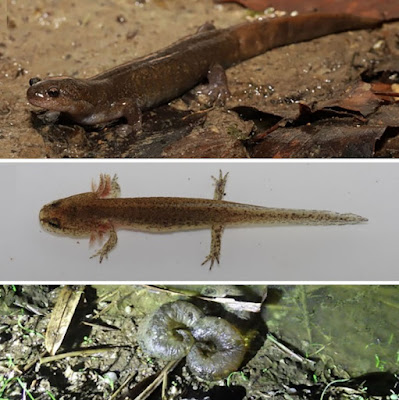 |
Light microscopy (LM) images of Galapagomystides patricki n. sp. A—in situ Galapagomystides inside Vestimentiferan tube, Alvin Dive 4508, Mound Quepos, Parrita Seep, Costa Rica, paratype (SIO-BIC A13420; A13420). B—dorsal view of anterior, paratype (SIO-BIC A1424).
in situ dorsal-view images of Galapagomystides verenae n. comb. associated with juvenile Escarpia spicata tubes at Parrita Seep off Costa Rica.
Pearson & Rouse, 2022 |
Abstract
Galapagomystides is an exclusively deep-sea group of Phyllodocidae, originally erected for Galapagomystides aristata from hydrothermal vents of the Galapagos Rift. In this study, Phyllodocidae collected from hydrothermal vents and methane seeps from the Pacific Ocean, including specimens from vents of the East Pacific Rise identified as Galapagomystides were studied using morphology (light microscopy and scanning electron microscopy) and DNA sequence data. Phylogenetic analysis of the newly generated molecular data (cytochrome c oxidase subunit I, 16S rRNA, 18S rRNA, and 28S rRNA) combined with an already available extensive dataset for Phyllodocidae resulted in a monophyletic Galapagomystides comprising five species. Galapagomystides aristata was found to occur on the East Pacific Rise vents as well as the Galapagos Rift and is redescribed. Two new species were from hydrothermal vents in the West Pacific, G. bobpearsoni n. sp., and G. kathyae n. sp., as well as one new species from a cold seep in the eastern Pacific, G. patricki n. sp. These new species are formally described, and a previously known vent species, Protomystides verenae, is redescribed and transferred to Galapagomystides. Galapagomystides verenae n. comb. was found to occur in both vents and seeps in the eastern Pacific, from Oregon to Costa Rica. The diagnosis of Galapagomystides is amended and the biogeography and habitat evolution of the five species of Galapagomystides is discussed.
Key words: new species, hydrothermal vents, methane seeps, cold seeps, Pacific Ocean, Aciculata, Phyllodocida
 |
A & B—in situ dorsal-view images of Galapagomystides verenae n. comb. associated with juvenile Escarpia spicata tubes at Parrita Seep off Costa Rica. |
Galapagomystides Blake, 1985 (emended)
(Pleijel 1991; Blake 1994)
Type species. Galapagomystides aristata Blake, 1985
Diagnosis (emended). Prostomium wider than long. Two antennae; two palps similar in size/shape to antennae. No median antenna or nuchal papilla. Nuchal organs unknown. Eyes absent. Smooth proboscis, papillae at distal end. Segment 1 fused or not (dorsally) to prostomium. Segment 1 distinct ventrally. Elongated dorsal cirri (EDC) (= tentacular cirri) on segments 1, 2; EDC on segment 3. No ventral cirri on segment 1. Ventral cirri on segment 2 elongated or like following segments. Parapodia uniramous, notopodial chaetae absent. Neuropodium with central fascicle containing compound chaetae; one simple emergent acicula. Compound chaetal shaft cylindrical; pointed blade extended from falcate joint. Rostrum of chaetal shaft asymmetrical/hooked. Presence of segmental bands of cilia. Pygidial cirri robust ellipsoid lobes. Living animals are red.
Galapagomystides aristata Blake 1985
Diagnosis. First segment fused dorsally to prostomium. Elongated dorsal cirri on segments 1 and 2. Elongated ventral cirri on segment 2. Exaggerated hook-like joint of compound chaetae.
Galapagomystides verenae (Blake and Hilbig 1990) new combination
Diagnosis. First segment not fused to prostomium. Trapezoidal prostomium that is dorsally “V” shaped posteriorly. Elongated dorsal cirri on segments 1, 2 and 3. Elongated ventral cirri on segment 2.
Galapagomystides bobpearsoni n. sp.
Diagnosis. First segment fused dorsally to prostomium. Elongated dorsal cirri on segments 1, 2 and 3. The elongated dorsal cirri on segments 2 and 3 are the longest of all Galapagomystides species. Elongated ventral cirri on segment 2.
Etymology. Galapagomystides bobpearsoni n. sp. is named after the lead author’s father, Bob Pearson, for his invaluable love and support, and who inspired the lead author’s passion and curiosity for the ocean.
Galapagomystides kathyae n. sp.
Diagnosis. First segment fused dorsally to prostomium. Wider prostomium. Elongated dorsal cirri on segments 1, 2 and 3. Elongated ventral cirri on segment 2.
Etymology. Galapagomystides kathyae n. sp. is named after the lead author’s mother, Kathy Reimer-Pearson, for her invaluable love and support, and who sparked the lead-author’s interest and enthrallment in invertebrates.
 |
Light microscopy (LM) images of Galapagomystides patricki n. sp.
A—in situ Galapagomystides inside Vestimentiferan tube, Alvin Dive 4508, Mound Quepos, Parrita Seep, Costa Rica, paratype (SIO-BIC A13420; A13420).
B—dorsal view of anterior, paratype (SIO-BIC A1424). |
Galapagomystides patricki n. sp.
Diagnosis. First segment not fused to prostomium. Elongated dorsal cirri on segments 1 and 2. No elongated ventral cirri.
Etymology: Galapagomystides patricki n. sp. is named after Patrick Shaughnessy, whose love and support during this project was instrumental to the lead author’s success.
Kaila A. M. Pearson and Greg W. Rouse. 2022. Vampire Worms: A Revision of
Galapagomystides (Phyllodocidae, Annelida), with the Description of Three New Species.
Zootaxa. 5128(4); 451-485. DOI:
10.11646/zootaxa.5128.4.1

















































